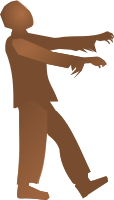
47 Users Online
Revision: 20140311_195601 | All Revisions

Different scenarios, based on military simulation (mil-sim), makes airsoft and paintball battles fun. They allow players to re-enact combat situations and exercise combat strategies for fun and enjoyment. These different game types are suitable for both indoor and outdoors environment. But the environment needs to be well controlled--such as at an airsoft/paintball field--for safety concerns.
In this article, we outlines the rules and winning criteria for numerous military simulation game types. Using these games types, you can add flavor to your war games. If the referees at your airsoft or paintball field are constantly running force-on-force games, direct them to this page to help spice things up.

The most simplistic war game is the one where all players on the field have to "kill" every other player. There is no team concept in this game type, which is why it is called "Free for All". The last man standing is the winner of the round.

As soon as you have the "Free for All" concept, people start thinking of teams. As the name imply, "Force on Force" is a game where two teams attempts to eliminate the other team. In video games , this game type is referred to as "Team Deathmatch". The last surviving team is the winner of the round.
The game could get more complicated as you introduce a third or forth team. In such cases, the war game become "Free for All" at the team level, but remains "Force on Force" at the individual level.
This game type can even get more complex and interesting when you fit teams into real-life mil-sim roles. For example, forces can consist or U.S. Army, U.S. Marine Corp, Russian Spetsnaz, Iraq Intelligence, etc.

In this game type, an item, called "football" or whatever mil-sim item it symbolizes, is placed somewhere on the field. Each team have to retrieve the item and take it to the enemy goal. When the carrier is shot, he/she must drop the "football" straight down. The "football" may not be thrown. The team that brings the "football" to the enemy's goal wins.

In this mil-sim scenario, one team must escort the very important person (VIP) from one location on the map to another location on the map. If the VIP is shot, then the escorting team loses and the opposition team wins. The reverse is true if the VIP reaches the destination.

In this game, each team has a flag at the home base. Each oppositions must reach the enemy's base to raise the flag. First team that successfully raises the flag wins the round.
In this game scenario, each team has a flag at the home base. Each oppositions must reach the enemy's base to grab the flag. One the flag is in possession, the individual, with the help of the team, must bring the enemy's flag back to home base. If the individual is shot, he/she must drop the flag straight down to the ground. First team that successfully brings the enemy's flag back to home base wins the round.
Dating game starts off as "Free for All" games. However, as individuals are shot, they sit down on the ground to be saved. The individual is saved when a "living" soldier tap him/her on the body. The individual is then on the savior's team, turning the game into "Force on Force" with many possible teams. From this point, the game can take two distinct routes. In one route, the team size can be limited. In the second route, the team size is unlimited.
In the limited route, the team has a maximum team member size. When the team reaches that size, the team can no longer save anyone. But if anyone the team dies, the member can be replaced by saving someone. The game is over when one team survives and everyone else is "dead". The team that survives win. In the rare situation where everyone dies, nobody wins.
The unlimited team size route can also be fun and interesting, because in the end, when everyone is on the same team, "alive", everyone wins. There is a rare chance that everyone dies. In that case, no one wins.

In manhunt, it is one team against one individual. The team must hunt down the individual, while the individual either eliminates the team or reaches extraction zone. This is a high adrenaline for the individual, but is great practice for evading enemies under pressure.

In this mil-sim scenario, one or more civilians are taken hostage by terrorists. One team acts as the terrorist, while the other team is the special operation rescue team (e.g. SWAT). The goal of the rescue team is to reach the hostage(s), secure their safety, and escort them to the extraction point. Note that the extraction point do not have to be the same as the insertion point.
The goal of the terrorists is to prevent the rescue team from reaching the hostage and extracting the hostage. The terrorists cannot kill the hostages until the hostage are in the rescue team's possession. The terrorists win when the rescue team is eliminated with hostage(s) in possession. The terrorists lose when the hostage(s) are killed prematurely, when the hostage(s) reach extraction point, or have no hostage(s) when the rescue team is eliminated.
The rescue team wins when the hostage(s) reach extraction point or when all of the terrorists are eliminated. To make the game more exciting and realistic, the rescue team should maintain minimum casualty; the mission should be considered a failure with high casualty.
Because this is real-life simulation, in this game scenario, both team can actually lose: 1) terrorists are eliminated, but hostages are dead and/or rescue team accumulates high casualty; 2) both rescue team and hostage(s) are eliminated.
A variation of hostage rescue is Prisoners-of-War (POW). In this game mode, both team are military forces. Either one side or both side have prisoners from the other side in possession. The team must secure their prisoners while rescuing captured team members.

And how can we ever forget the zombie games? The zombie game type is very similar to "Manhunt". There is basically a group of zombies hunting a very small group of individuals.
The zombies cannot wield weapons, while the group of individuals can wield weapons with limited ammunition. The zombie may walk slowly or at a pace agreed upon. When the zombie(s) touch a "living" individual, the individual turns into a zombie. The individuals must survive the zombie pursue and reach a safe point.
This is a great game for low power airsoft guns (LPEG). The limited FPS helps keep the quiet zombie atmosphere intact. And it keeps all the zombie spirits up with really close-quarter shooting that is risky for high power airsoft guns (HPEG). 150 FPS with 0.2g BBs should be the limit for this game.